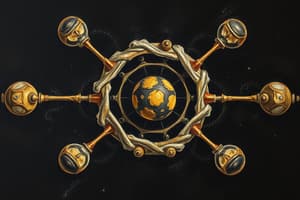Podcast
Questions and Answers
What is an element?
What is an element?
- Any substance that can be broken down into simpler substances
- A substance made of only one kind of atom (correct)
- A mixture of different types of atoms
- None of the above
What is the smallest unit of an element?
What is the smallest unit of an element?
atom
What does the atomic number represent?
What does the atomic number represent?
the number of protons in an atom
What is the center of an atom called?
What is the center of an atom called?
What does the atomic mass number signify?
What does the atomic mass number signify?
All elements can be broken down into simpler substances.
All elements can be broken down into simpler substances.
Which of the following is true about chemical symbols?
Which of the following is true about chemical symbols?
What happens when the first letter of an element's name has been used as a symbol for another element?
What happens when the first letter of an element's name has been used as a symbol for another element?
Describe what occurs if you cut an atom of gold into smaller pieces.
Describe what occurs if you cut an atom of gold into smaller pieces.
What are examples of pure substances called elements?
What are examples of pure substances called elements?
What is the Periodic Table of Elements?
What is the Periodic Table of Elements?
How many different kinds of atoms are there approximately?
How many different kinds of atoms are there approximately?
Electrons have a much greater mass than protons and neutrons.
Electrons have a much greater mass than protons and neutrons.
What charge do neutrons have?
What charge do neutrons have?
What is the name of the charge that an atom has when it has the same number of protons and electrons?
What is the name of the charge that an atom has when it has the same number of protons and electrons?
In a chemical symbol, how is capitalization applied when two letters are used?
In a chemical symbol, how is capitalization applied when two letters are used?
Flashcards are hidden until you start studying
Study Notes
Elements and Atoms
- An element is a pure substance that cannot be broken down into simpler substances, consisting of only one type of atom.
- An atom is the smallest unit of an element and is comprised of protons, neutrons, and electrons.
- Atomic number refers to the count of protons in an atom's nucleus, uniquely identifying an element.
- The nucleus is the atom's core, containing protons and neutrons, with a dense structure held together by a strong force.
Atomic Mass and Properties
- Atomic mass number is the sum of protons and neutrons in the nucleus of an atom.
- An element remains unchanged even when heated or subjected to chemical processes.
Structure of Atoms
- An atom consists of three particles:
- Protons (+1 charge)
- Neutrons (neutral charge)
- Electrons (-1 charge)
- Electrons occupy the space around the nucleus, forming an electron cloud rather than traveling in fixed orbits.
- Approximately 50,000 aluminum atoms equal the thickness of aluminum foil; a penny contains roughly 20 billion atoms.
Chemical Symbols and Periodic Table
- Chemical symbols are one or two-letter representations of elements, with the first letter capitalized and the second letter in lowercase.
- The Periodic Table of the Elements organizes elements by increasing atomic number and groups elements into families based on similar properties.
Key Facts about Atoms
- Each element has a specific atomic number; e.g., hydrogen has 1 proton, helium has 2, and radium has 92.
- There are about 118 different types of atoms (elements) identified.
- Atoms are the building blocks of matter and can combine to form compounds.
Specific Element Information
- Silver:
- Protons: 47, Neutrons: 61, Electrons: 49,
- Atomic No: 47, Mass No: 108, Charge: -2.
- Plutonium:
- Protons: 94, Neutrons: 150, Electrons: 99,
- Atomic No: 94, Mass No: 244, Charge: -5.
- Bismuth:
- Protons: 83, Neutrons: 126, Electrons: 99,
- Atomic No: 83, Mass No: 209, Charge: 0.
- Calcium:
- Protons: 20, Neutrons: 20, Electrons: 17,
- Atomic No: 20, Mass No: 40, Charge: +3.
- Radon:
- Protons: 86, Neutrons: 136, Electrons: 81,
- Atomic No: 86, Mass No: 222, Charge: +5.
Element Symbols
- Aluminum (Al), Bromine (Br), Calcium (Ca), Carbon (C), Gold (Au), Copper (Cu), Hydrogen (H), Iron (Fe), Oxygen (O), Phosphorus (P), Sodium (Na), Sulfur (S).
Studying That Suits You
Use AI to generate personalized quizzes and flashcards to suit your learning preferences.




